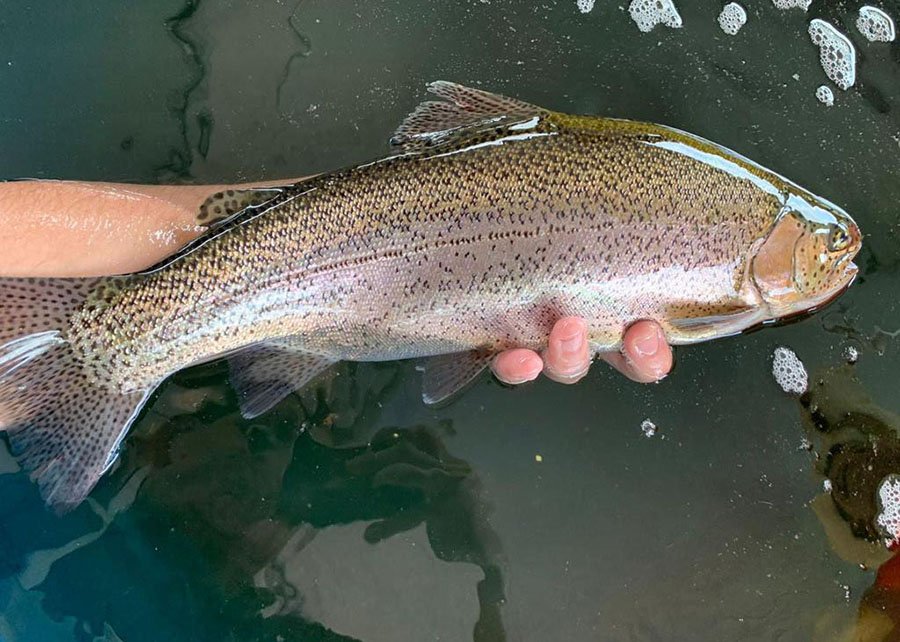
Current supplies of fishmeal cannot sustain the growth of the aquaculture industry, particularly for carnivorous species like trout. Plant-based alternatives, while readily available, may not provide all the nutrients fish need, affecting growth and health.
In a study published in the journal Aquaculture Research, scientists from Georg-August-University (Germany) reported the results of their research on whether rainbow trout can fully adapt to diets containing only black soldier fly (BSF) larvae meal or spirulina as a protein source. This could pave the way for breeding programs to develop fish specifically adapted to these sustainable feeds.
Promising new options: insects and microalgae
Researchers are exploring sustainable alternatives for fish feed, and two promising candidates are insects and microalgae.
- Black soldier fly (BSF) larvae: These fly larvae can be mass-produced efficiently and offer a good amino acid profile, similar to fishmeal (except for lysine and methionine). The EU even approved their use in fish feed in 2017! Studies show that BSF meal can replace significant amounts of fishmeal without harming fish health or growth.
- Spirulina: This microalga boasts a high protein content with all essential amino acids, along with valuable vitamins, minerals, and fatty acids. Studies suggest that spirulina can improve growth, meat quality, and immunity in some fish species.
Studies have shown promising results for the partial replacement of fishmeal with BSF meal (up to 50%) and spirulina (up to 75%).
The Experiment
Researchers conducted a feeding trial with 495 juvenile rainbow trout of two types: a commercial breed and three local lines. They compared:
- Local strains versus commercial: The study compared the performance of local rainbow trout strains with a commercially improved strain.
- Total fishmeal replacement: Researchers aimed to achieve 100% fishmeal replacement with BSF or spirulina.
Three diets were formulated:
- Control diet: Containing 20% fishmeal (standard practice).
- Insect meal diet: Completely replacing fishmeal with partially defatted Hermetia meal (derived from black soldier fly larvae).
- Microalgae diet: Completely replacing fishmeal with spray-dried spirulina powder.
All diets were designed to have the same amount of protein and energy; fish were fed for 56 days, and their growth rate, feed utilization, and protein utilization were monitored.
Study Results
- Success in fishmeal replacement: Both the insect meal and microalgae powder diets supported healthy growth of rainbow trout, comparable to the control fishmeal diet. This suggests they can be viable alternatives.
- Breed matters: The commercial breed exhibited the fastest growth rate but also had the poorest feed conversion ratio (meaning they wasted more feed). The local strains, though growing slightly slower, utilized feed more efficiently.
- Protein power: The local strains, regardless of diet, demonstrated superior protein utilization compared to the commercial breed.
- Initial weight influence: Differences in initial fish size might have affected the results. Smaller fish may have shown “compensatory growth,” meaning they grew faster to catch up with their larger counterparts.
Conclusion
“The present study has demonstrated that FM can be completely replaced by HM or SP in diets for rainbow trout without negative effects on growth performance,” the scientists conclude. Thus, the study shows the potential of insect meal and microalgae powder as sustainable substitutes for fishmeal in rainbow trout diets.
Stay Always Informed
Join our communities to instantly receive the most important news, reports, and analysis from the aquaculture industry.
By finding sustainable and efficient protein sources for farmed fish, researchers are paving the way for a more environmentally responsible aquaculture industry. This benefits not only the environment but also consumers seeking healthy and ethically raised fish.
The study was funded by the Lower Saxony Ministry of Science and Culture (Germany).
Contact
Angela Sünder
Georg-August-University, Faculty of Agricultural Sciences, Department of Animal Sciences, Division Animal Nutrition Physiology
Göttingen 37077, Germany
Email: angela.suender@agr.uni-goettingen.de
Reference (open access)
Dietz, C., Wessels, S., Sünder, A., Sharifi, R., Gährken, J., & Liebert, F. (2023). Does Genetic Background of Rainbow Trout Impact Growth and Feed Utilisation following Fishmeal Substitution by Partly Defatted Insect Meal (Hermetia illucens) or Microalgae Powder (Arthrospira platensis)? Aquaculture Research, 2023(1), 4774048. https://doi.org/10.1155/2023/4774048
Editor at the digital magazine AquaHoy. He holds a degree in Aquaculture Biology from the National University of Santa (UNS) and a Master’s degree in Science and Innovation Management from the Polytechnic University of Valencia, with postgraduate diplomas in Business Innovation and Innovation Management. He possesses extensive experience in the aquaculture and fisheries sector, having led the Fisheries Innovation Unit of the National Program for Innovation in Fisheries and Aquaculture (PNIPA). He has served as a senior consultant in technology watch, an innovation project formulator and advisor, and a lecturer at UNS. He is a member of the Peruvian College of Biologists and was recognized by the World Aquaculture Society (WAS) in 2016 for his contribution to aquaculture.




